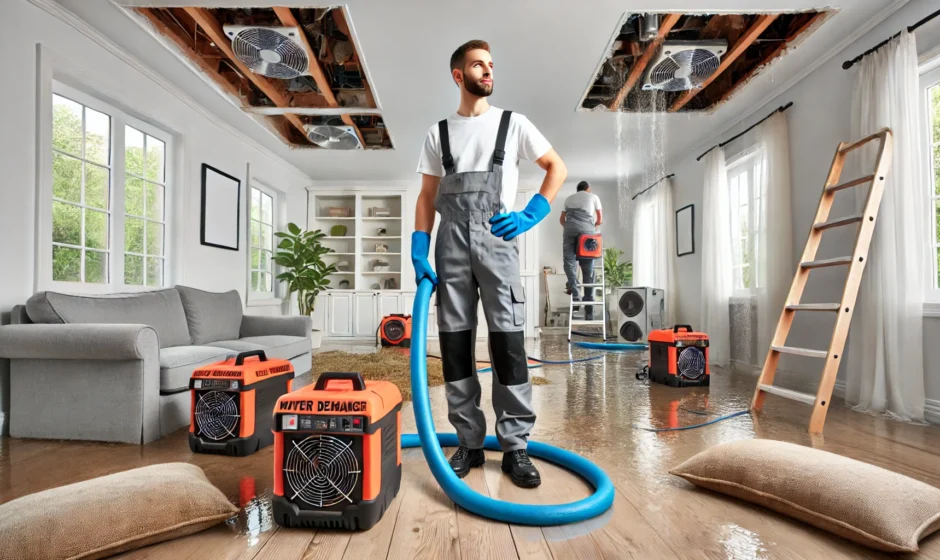For homeowners, water damage can be their greatest fear. Water intrusion, whether due to a burst pipe, flooding, or a leaky roof, can cause structural problems, mold growth, and property damage if not dealt with quickly. The key to minimizing damage and restoring your property efficiently is knowing the right steps to take immediately after water damage occurs. In this guide, we will walk you through the essential steps of water damage restoration, helping you recover your home or business quickly and safely.
Step 1: Ensure Safety First
Before you begin any restoration efforts, it’s crucial to prioritize safety. If the water damage is severe, such as in the case of a flood or major leak, turn off the electricity and gas supply to prevent electrical hazards and gas leaks. Avoid walking through standing water, as it may be contaminated with bacteria, chemicals, or sewage. If the damage is extensive, consider evacuating the premises until professionals assess the situation.
Step 2: Identify the Source and Stop the Water Flow
Once it’s safe to do so, locate the source of the water intrusion. In cases of plumbing issues, shut off the main water supply to stop further flooding. If the water is coming from a leaking roof or windows, take temporary measures such as covering openings with tarps or sealing cracks to prevent additional water entry. Addressing the source quickly is a critical step in the water damage restoration process, as it prevents further damage and mold growth.
Step 3: Remove Excess Water Immediately
The longer water sits, the greater the damage. Use mops, towels, and buckets to soak up small amounts of water. For larger floods, consider using a wet/dry vacuum to extract standing water. If the affected area is substantial, water damage professionals have industrial-grade pumps and vacuums to remove water efficiently.
Opening windows and doors can improve ventilation, which helps speed up drying. Dehumidifiers and fans are also useful for reducing moisture levels in the air. Proper air circulation can prevent mold and mildew from forming, which can occur within 24-48 hours of water exposure.
Step 4: Remove and Protect Belongings
Move furniture, electronics, and personal belongings to a dry, safe location to prevent further damage. Upholstered furniture, carpets, and rugs that have absorbed water should be dried as quickly as possible to avoid mold growth. Wooden furniture should be wiped dry and placed in a well-ventilated area to prevent warping.
For items that have suffered severe water damage, assess whether they can be salvaged or need to be discarded. Documents, photographs, and books can sometimes be restored using professional drying techniques, but acting quickly is crucial.
Step 5: Dry and Dehumidify the Affected Area
Even after standing water is removed, excess moisture can linger in walls, flooring, and furniture. Using dehumidifiers, air movers, and fans can help accelerate the drying process. If drywall or insulation has absorbed water, it may need to be removed and replaced to prevent mold growth.
Check hidden areas such as under carpets, behind walls, and inside cabinets for trapped moisture. Infrared cameras and moisture meters can help detect areas that still contain excess water, ensuring a thorough drying process.
Step 6: Clean and Sanitize the Space
Water damage often brings bacteria, contaminants, and mold spores into your home. To ensure a safe environment, disinfect all affected surfaces with appropriate cleaning solutions. Floors, walls, and furniture should be thoroughly sanitized to remove any potential health hazards. If mold has begun to develop, specialized mold remediation treatments may be required.
Step 7: Repair and Restore Damaged Areas
Once the area is dry and sanitized, it’s time to start repairs. Depending on the extent of the damage, this could involve replacing drywall, repainting walls, installing new flooring, or even reconstructing parts of the home. In cases of structural damage, consulting a professional contractor is essential to ensure safe and effective repairs.
Restoring personal items such as furniture, appliances, and decor is also part of the recovery process. Some items may require professional cleaning or repair services, while others may need to be replaced entirely.
Step 8: Prevent Future Water Damage
After dealing with the immediate aftermath, take steps to prevent future water damage. Regularly inspect your plumbing system, roof, and gutters for leaks or weak points. Installing a sump pump, sealing foundation cracks, and ensuring proper drainage around your home can significantly reduce the risk of future water intrusion.
Additionally, consider using water leak detection devices that alert you to leaks before they cause significant damage. Routine maintenance and early detection are key to keeping your property safe from future water-related issues.
When to Call a Professional
While minor water damage can often be handled independently, severe cases require professional intervention. If you experience extensive flooding, sewage backup, or persistent mold growth, seeking professional water damage restoration services is the best course of action. Experts have the tools, knowledge, and experience to handle large-scale water damage, ensuring thorough drying, sanitization, and restoration of your property.
Conclusion
Recovering from water damage can be overwhelming, but taking the right steps can make the process more manageable. Acting quickly, ensuring thorough drying, and implementing preventive measures can protect your home and belongings from further damage. When in doubt, seeking professional water damage restoration services ensures a safe and efficient recovery process. By staying prepared and proactive, you can safeguard your property from future water-related disasters and restore your space to its original condition.



